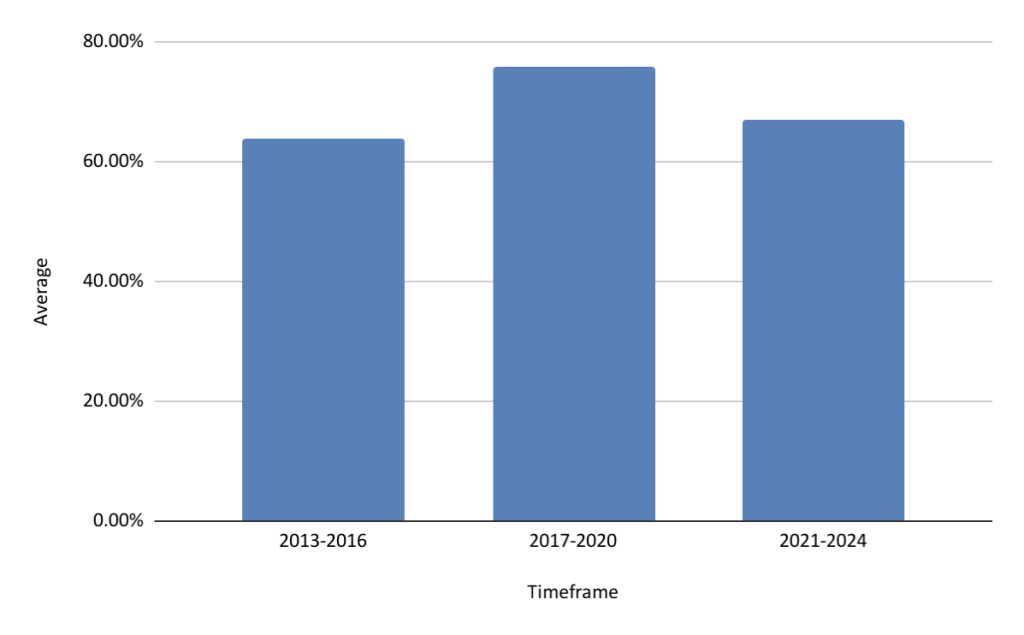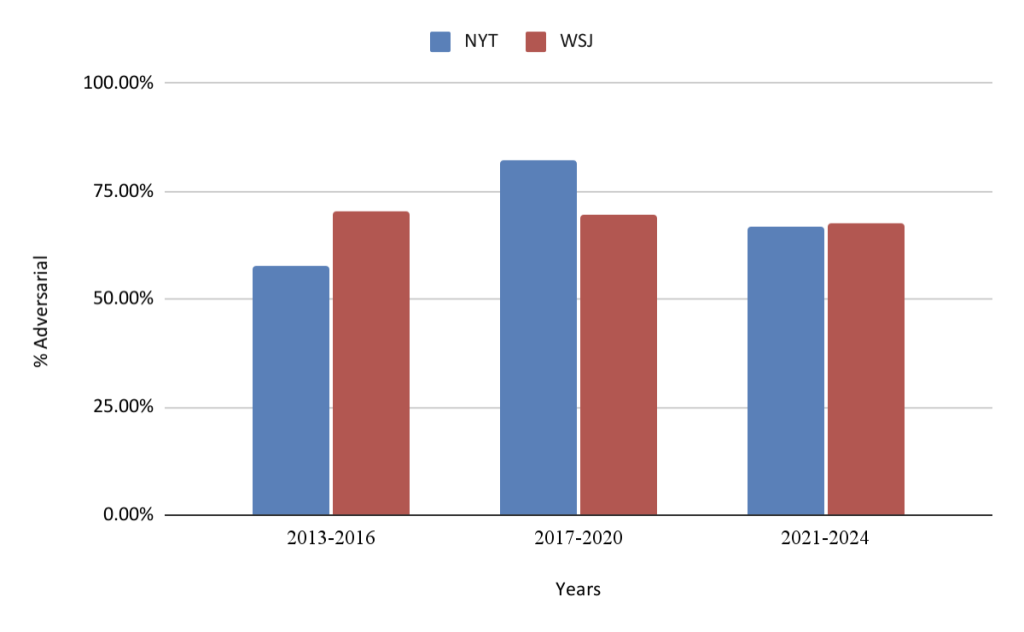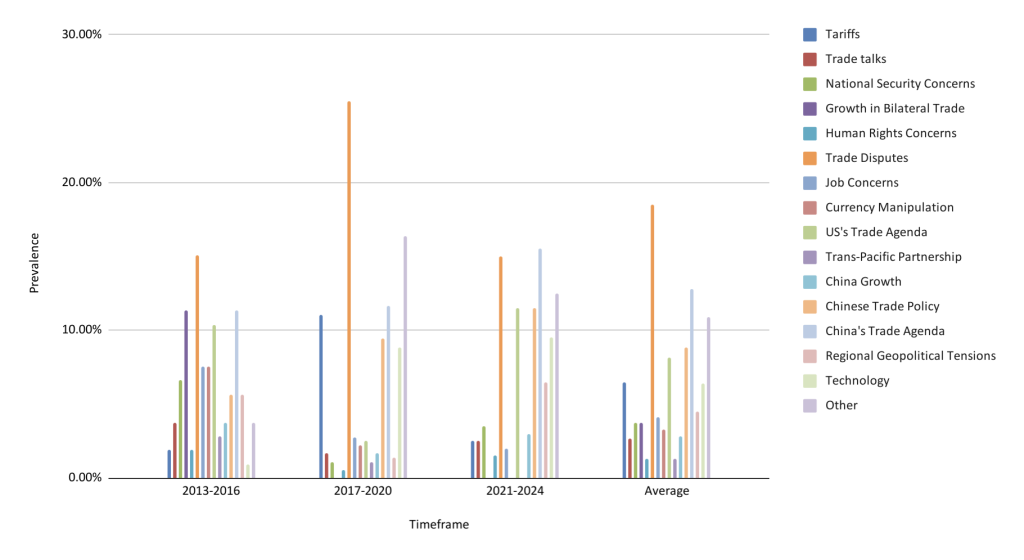
Author: Yuan Peng
Mentor: Dr. Bart Bonikowski
Cate School
Introduction
Trade between the United States (US) and China, the world’s largest economies, has been turbulent over the past decade. China became the US’s largest trading partner in November 2013, and it remained that way for the larger part of the past decade, but due to the ongoing trade war between the two countries, and an increasingly hostile sentiment in both countries due to geopolitical conflicts, Mexico surpassed China as the US’s biggest trading partner in February of 2021 (US Census Bureau Foreign Trade, n.d.). The continued erosion of diplomatic as well as economic relations between the US and China poses implications for the world at large (S&P Global, n.d.).
In the US, China’s image has continued to sour, reaching an all-time low in 2023 as a result of COVID-19 and amid mounting trade tensions; Pew reported that in 2023, some 83% of US adults held unfavorable views of China (Fagan, 2023). This negative perception is further fueled and reflected by the news media, which has long played a central role in shaping both public opinion and policymakers’ perspectives on international affairs (Chen & Wang, 2022; Cyber-Diplomacy, 2002).
The U.S. stance on trade with China has shifted significantly under the administrations of Presidents Obama, Trump, and Biden, with unfavorable views of China rising by 29% during Trump’s presidency, as he treated China as an economic and military “enemy” (Higgins, 2019). Since hard news coverage sets the tone of ongoing policy issues, public perceptions are likely to be reflected in media coverage. Studying that media coverage directly can help us understand the media’s agenda-setting role with respect to US-China trade relations.
In this study, I investigate firstly how the tone of US media coverage of trade with China has changed over time. Additionally, I ask whether the media increasingly portrayed China in a negative light during the Trump administration and whether the tone of the coverage returned to its pre-Trump baseline during the Biden administration. Additionally, to explore the effect of political alignment on news reporting and determine whether the political skew of news media affects coverage of trade with China, I ask the following question: How does the political alignment of a media source affect its coverage of trade with China? Along with studying the general trends in media coverage over time, I will also study the topics and concerns that influence perception and perception changes the most by asking the following question: what topics influence the tone of media coverage on trade with China the most?
To investigate these questions, I use newspaper article data from the Wall Street Journal (WSJ) and the New York Times (NYT) across three consecutive time periods (2013-2016, 2017-2020, 2021-2024). A total of 91 relevant articles from the NYT and 129 relevant articles from the WSJ were coded for the general tone and specific mentions of trade with China. I analyzed quotations and general trends in Google Sheets.
I find that US media portrayals of China worsened over time, and soured particularly during the Trump administration. Additionally, I find that while the left-leaning New York Times was susceptible to administration changes, the Wall Street Journal’s portrayals remained largely consistent over the years. Topics such as tariffs, technology, and trade disputes, were the main focuses of US news media. By studying the changes in US media portrayal of trade with China, this research aims to further understand the role of US media in US-China trade relations.
Literature Review
1. China-US Trade Relations
To encapsulate the development of the US-China trade relations, researchers point to a few key events. China’s trade relations with the US were defined most notably by China joining the WTO in 2001, the 2008 financial crisis and its aftermath (Chen & Wang, 2022). While the relationship was initially positive, the relationship began to deteriorate, starting with smaller and separate disputes that eventually developed into a full-fledged trade war. In recent years, researchers point to events such as the establishment of the Trans-Pacific Partnership, the official start of the US-China trade war that began with the introduction of new US tariffs on solar panels in 2018, and even events that appear less related to trade, such as the COVID-19 epidemic, or human rights in Tibet (Ramirez & Rong, 2012; Tang & Willnat, 2023). Overall, the US’s grievances against China have centered around a few issues: China’s trade practices, most notably its alleged currency manipulation, forced intellectual property (IP) transfers, as well as the China-US trade deficit (Ramirez & Rong, 2012, p. 1). While previous literature has studied US perceptions of China over generally shorter time frames, such as those following COVID-19, this research will study the US tone of media coverage on trade with China over a longer period of time, thus providing a broader understanding of trends in the tone of media coverage over time.
2. Political Differences
Both the contemporary political environment as well as the political skew of media outlets have an impact on their general stance on China. Hard news both reflects and informs the general sentiments of the population at any time. Under three different administrations since 2013, the US’s perception of China has become increasingly adversarial. Most notably, the Trump Administration treated China as an economic and military “enemy”; and according to a Pew survey, the share of Americans holding unfavorable views of China grew by 29% during the time Trump was in office (2017-2021) (Fagan, 2023; Higgins, 2019). In general, liberals and conservatives are divided in their views of China, with conservatives likely to be more adversarial (Jin et al., 2022, p. 4). This division is reflective of the general party stance as well as actions and rhetoric employed by respective administrations while in office. While previous literature has mainly focused on influences of political alignment on perceptions of China in general within the general population, this research aims to analyze that influence in news media, both in terms of bias as well as the administration in power.
3. Role of Media on International Trade
The media represents one of the primary channels through which individuals consume information on international affairs and public opinion, which in turn influence the perception people have of certain countries (Wanta & Golan, 2004). Media portrayals influence policymakers as well, and even with the rise of social media today traditional news media continues to be a source of information for politicians (Cyber-Diplomacy, 2002). As a result, news media often also serves as a mirror, reflecting the nation’s identity and political and trade agenda (Cook, 2005). Therefore, analysis of trends in hard news will examine how media sets the agenda of public debates and shapes public opinion. While most literature confined news analysis to shorter timeframes or neglected to compare separate US outlets with each other, this research aims to study the impact of news media over a more extensive timeframe and seeks to compare key topics’ presence in news to help better understand the issues and topics that drive perceptions on US trade with China.
4. Hypotheses
Republicans have consistently held more negative views on China as opposed to Democrats and previous surveys have revealed the significant souring of China’s perception in the US during the Trump administration (Fagan, 2023; Huang, 2020). Overall, this suggests that under the Trump administration, media perception of China follows the general trend and therefore also becomes more negative. I therefore propose:
Hypothesis 1: media coverage of trade with China will be the most adversarial in the years of Trump’s presidency (2017-2021) and less so in the four years before that and in the time up till now.
The effect of the trade war as well as COVID-19 on the tone of media coverage of China is also likely to leave lasting impacts. Indeed, the Trump administration introduced various elements of uncertainty to trade relations between the US and China, such as the initiation of the trade war in 2018. Additionally, the Biden administration has continued to place additional tariffs on China, such as the increase in import taxes on Chinese EVs, and has preserved various Trump-era tariffs. I therefore propose:
Hypothesis 2a: the tone of media coverage of trade with China remains relatively negative post-Trump.
However, since political rhetoric during the Biden administration has also proven to be significantly less preposterous, there is the likelihood that media coverage has toned down during his administration. This leads me to propose:
Hypothesis 2b: the tone of media coverage of trade with China recovers and returns to pre-Trump levels during the Biden administration.
Since Republicans tend to view China more negatively, I therefore pose:
Hypothesis 3: media coverage of trade with China in right-leaning news media (such as WSJ) will be more adversarial than those in left-leaning news media (such as NYT).
As the US increasingly views rising China and its growing economic influence in the world as a national security threat, and as tariffs and grievances focus increasingly on a few certain topics, I suggest:
Hypothesis 4: topics such as cybersecurity, technology, trade deficit, and China’s trade tactics and regulations will affect US media coverage the most.
Data and Methods
1. Data
Data for this study was made up of relevant news reports and op-eds published in the New York Times and the Wall Street Journal between 1 January 2013 and 8 February 2024 to cover the three most recent administrations. A total of 220 relevant articles were obtained, of which 91 were from NYT and 129 were from WSJ.
I divided the larger timeframe into three four-year time frames to cover the three respective administrations of Obama, Trump, and, now, Biden. I made a search in the ProQuest database using the terms “China” and “trade” within a vicinity of five words and in a timeframe of a week. 21 weeks were selected at random within each four-year period in order to craft a purposeful sample due to the large volume of the available data; specifically, 21 weeks represents about 10% of the total time in any four-year time period. All relevant articles were collated and downloaded so that each file represented all relevant articles within a week. To ensure that all articles fell under the category of hard news, opinion and commentary pieces, including editorials, were excluded during coding. Additionally, articles that were irrelevant thematically were also marked as so and discarded during coding.
The New York Times and Wall Street Journal were chosen as targets for this research because of their respective political leanings. These two publications fulfill the requirement of having broad media coverage as well as being sufficiently different in terms of political alignment. Ad Fontes Media rating of NYT has it at a relatively reliable 41.91 and a -7.94 bias rating (on a scale of 42, where neutral is 0 and extremely left-leaning is -42 while the extreme right is +42). On the other hand, WSJ was rated at 43.34 reliability and +4.24 bias. While the New York Times is slightly more skewed compared to the Wall Street Journal, a better pair of outlets could not be found as the type and accessibility of the publications data was also a limiting factor (Interactive Media Bias Chart, n.d.).
2. Coding
I conducted the coding of news articles to systematically analyze the portrayal of trade relations between the U.S. and China in the media and to answer the four research questions. The goal of coding was to identify the general sentiment on trade with China in each of the three time frames for the two different news outlets, as well as identify the topics that were most relevant to these sentiments.
To classify the articles, I developed a systematic coding scheme. There were five code categories, some were developed iteratively while others were set from the beginning. These were “General Tone,” “Perception of China,” “Quote/Not Quote,” “Speaker,” and “Substantive Domain.” The former four categories were set from the beginning while the “Substantive Domain” codes developed as coding progressed. “General Tone,” and “Perception of China,” specifically analyze the tone that the speaker employs when describing trade with China. Negative or adversarial portrayals were when China was portrayed as causing great harm, having a trade agenda that was against the interests of the US, or being an adversary in the “trade war.” Positive portrayals were when China was portrayed as being a collaborator with the US on trade, or the relationship being one of mutual benefit. Neutral portrayals were when authors remained relatively neutral.
Coding was done manually using Atlas. ti. During coding, I first did a search of the article using the words “China” and “U.S.” to determine relevant sections, which I then read; if “China” and “U.S.” were consistently mentioned, the entire article was read. I coded sentences that characterized China in certain ways: whether “adversarial”, “neutral” or as “a partner.” Articles were coded as well for speaker and substantive domain. After reading, I coded the article as a whole on “General Tone,” which ranged from “Adversarial,” to “Neutral,” and “Positive.” Coding for the substantive domain was iterative and when the codebook was revised, I revisited and recoded previous articles; this proved not to be a challenge as topics were added as they appeared and overlapping codes merged at the end of the coding process. Challenges during the coding surrounded the coder bias, as coding became more consistent as the process went on. To address this, earlier articles were revisited and the coding was revised for consistency.
Codes and quotes were stored in Atlas.ti and exported to Google Sheets for analysis to ensure that the data was easily accessible and to enable more efficient analysis. Individual quotes occupied separate rows in the sheet and had properties discerning its outlet (NYT or WSJ), timeframe, week number, and separate properties for all existing codes (with binary 0s and 1s assigned in cells to indicate the codes assigned to the quote).
To analyze the change in general tone over time, I sorted quotes first by news outlet and then by timeframe; in this way quotes were separated by outlet and time, for example, all NYT articles from a certain timeframe were put together. For every timeframe, the number of articles having “Adversarial Portrayals” was divided by the number of total articles coded for “General Tone” to give the percentage of adversarial portrayals in the timeframe. I then organized the six percentages (three from NYT and three from WSJ representing the three timeframes) in a table and generated Figure 1 and Figure 2.
To analyze the trends in the substantive domain, I separated the data by timeframe exclusively, disregarding the specific news outlet. I divided the total appearances of a specific code under “Substantive Domain” in a certain timeframe by the total amount of “Substantive Domain” codes during the timeframe to give the percente of its prevalence during that specific time period. I then organized the resulting percentages into a chart and generated Figure 3.
Findings
To study how US media coverage of China has changed over the three most recent administrations and gauge Trump’s impact on media discourse, I compared the number of adversarial articles published in a given year to the total number of relevant articles in that same year. As shown in Figure 1, adversarial portrayals of China in the US media increased over the three four-year timeframes, from 63.98% between 2013-2016 to a high of 75.85% in 2017-2020, and finally decreasing to 67.12% in 2021-2024 but not returning to original levels. Overall, these findings indicate that news reporting was consistently more adversarial than not and its negative tone largely increased over the course of the three administrations, only decreasing slightly between the Trump and Biden administrations. Figure 1 also provides evidence for Hypothesis 1 concerning the media perception of China during Trump’s presidency. During the time Trump was in office (2017-2020), adversarial portrayals of China in news media grew by 11.87% from when Obama was in office. The adversarial portrayals of China were also the highest during that time compared to the two other timeframes, thus affirming the hypotheses.

Trump had a lasting impact on media coverage of trade with China. Figure 1 indicates that while adversarial media portrayals decreased (from 75.86% in 2017-2020 to 67.12% in 2021-2024), negative portrayals during the Biden administration have yet to return to the levels observed during the Obama administration. This suggests that while neither Hypothesis 2a nor 2b is fully right, the answer is somewhere in between the two. While political rhetoric and actions during the Trump administration had a negative lasting impact on coverage of trade with China, the tone did indeed improve between the Trump and Biden administrations.
To test how the political alignment of media outlets influenced media portrayals of China, the trends of adversarial portrayals were analyzed separately by newspaper over time. As shown in Figure 2, adversarial portrayals of trade with China in the New York Times rose sharply between the Obama and Trump administrations and recovered slightly in the Biden administration (Obama: 57.69%, Trump: 82.05 %, Biden: 66.67%). On the other hand, media portrayals by the Wall Street Journal have remained consistently adversarial (Obama: 70.27%, Trump: 69.64 %, Biden: 67.57%). This indicates that while left-leaning news was originally more optimistic and positive about trade with China, the mood soured drastically during the Trump administration, and in recent years, left and right-leaning media sources share a stance on trade with China. Thus, while hypothesis three was originally true in 2013-2016, the left-leaning NYT had significantly more negative portrayals of China during the Trump administration (NYT: 82.05% WSJ: 69.64%) and leveled out with right-leaning WSJ during the Biden administration.

On the contrary, however, the tone of reporting from the WSJ experienced little change over the course of the three administrations. Adversarial portrayals of trade with China remained largely steady (2013-2016: 70.27%, 2017-2020: 69.64%, 2021-2024: 67.57%). This indicates that while the NYT was more susceptible to changing political rhetoric, the reporting from the WSJ remained consistent.
To test how different topics or events influenced the tone of US media coverage of China differently over time, the substantive domain of passages in articles regarding trade with China was analyzed. Figure 3 shows the percent prevalence of specific topics and their change over the years. In 2013-2016, the most influential topics were “Trade Disputes”, “Growth in bilateral trade”, “China’s Trade Agenda,” and “US’s Trade Agenda” (15.09%, 11.32%, 11.32%, 10.32% respectively). “China’s Trade Agenda,” and “US’s Trade Agenda” respectively refer to the specific trade strategies or efforts by the two countries, for instance, the Trans-Pacific Partnership is classified under “US’s Trade Agenda.” During this time, the growth of bilateral trade between the two countries was reported extensively and was instrumental in informing the general media perception of trade with China. For reference, “Growth in Bilateral Trade” was not a significant factor in either 2017-2020 or 2021-2024. This is indicative of the fact that increased US trade with China was a relatively novel topic. Additionally exclusively in 2013-2016, the topics “Currency Manipulation” and “Job Concerns” were prevalent (both 7.55%). This is reflective of the specific concerns of the Obama Administration on increased trade with China during that specific timeframe. Later on, these specific concerns were not a primary focus.
During 2017-2020, “Trade Disputes” was the most influential topic (25.48%). “Trade Disputes” remained a hot topic throughout the three time frames (15.09% in 2013-2016; 15.00% in 2021-2024) but were about 10% more prevalent during 2013-2016. “Tariffs” also follow a similar trend, being the most prevalent during 2017-2020 at 11.08% (about 9% more prevalent than during either 2013-2016 or 2021-2024).

A connection can be drawn between these trends and specific policies enacted during the Trump administration, notably, the beginning of the US-China trade war. The increase in the prevalence of the topic of “Technology” during this specific time period is also indicative of the correlation between the political rhetoric of the Trump administration and specific media representations of trade with China. The topic “Technology” shot up in prevalence in 2017-2020 from 0.94% during the previous timeframe to 8.86%. This makes sense as a significant portion of US tariffs enacted on China during that period were on technologies, more specifically solar panels (York, 2024). Interestingly, however, technology remained a focus in 2021-2024, and its prevalence increased to 9.5%. This indicates that the Biden administration continued to focus on important technology industries in the US. This is mirrored, for example, in the Biden administration’s increased semiconductor, battery, EV, and medical product tariffs (The White House, 2024).
The topic “China’s Trade Policy” grew over the three timeframes (2013-2016: 5.66%, 2017-2020: 9.42%, 2021-2024: 11.50%). This indicates that the political rhetoric became increasingly frustrated with China’s trade practices as time went on.
Conclusion
In this study I set out to examine how US media coverage of trade with China changes based on a variety of factors: time, political environment, as well as political bias. I used two US-based hard-news outlets, the New York Times and the Wall Street Journal, two oppositely skewed outlets to collect relevant data. Employing qualitative coding and analysis methods, I gathered data and quantified and measured specific trends in US media perception of trade with China.
My findings suggest that although a variety of factors have influenced media coverage of trade with China, US media perception follows a general trend and is heavily influenced by the contemporary political environment as well as specific developments in US-China trade. In the past decade, changing political administrations and the corresponding political rhetoric as well as trade policies as played the primary role in driving change in media portrayals. Interestingly, the analysis found that while the right-leaning WSJ was consistently adversarial towards China in trade, the left-leaning NYT, while initially significantly friendlier was heavily influenced by the adversarial political rhetoric of the Trump Administration.
Media portrayals of trade with China play a huge role in informing the perception of the wider population as well as politicians and policy-makers. Understanding the how and why behind the changes in US media portrayals of trade with China is thus crucial to understanding the larger stance of the US on the issue. As trade disputes between the US and China continue to unravel, implications will be felt worldwide. This analysis of US media portrayals finds out what drives the US and paints a better picture of its stance on trade.
About the author

Yuan Peng
Y.A. Peng is a student at the Cate School with a strong passion for political science as well as community engagement. Yuan is deeply interested in US and China relations and how they play out, not only in the two countries but also in other regions in the world. Yuan is a leader on campus and is the co-founder of the debate and ethics club, as well as a Student DEI Representative. In his free time, he reads and has a passion for the visual arts.
